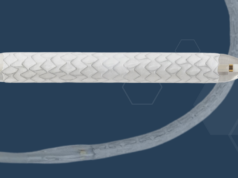
Endovascular aneurysm repair (EVAR) using the Zenith endograft (Cook Medical) represents durable repair with a low risk of abdominal aortic aneurysm-related death at 14 years, according to data presented by Fabio Verzini, professor of Vascular Surgery, University of Perugia, Italy, at the Vascular Annual Meeting (9–11 June, National Harbor, USA). Despite this, the long-term survival rate of 24% shows that long-term outcomes for EVAR “remain poor,” Verzini said.
“Long-term results of abdominal aortic aneurysm EVAR are affected by graft design renewals that tend to improve performances of older generations but usually reset follow-up times to zero,” Verzini told delegates. The study presented 14-year outcomes of EVAR using the Zenith graft, still in use without major modification, in a single-centre investigation.
Between 2000 and 2011, 610 patients representing the study group underwent elective EVAR using the Zenith endograft. Primary outcomes were overall survival, freedom from abdominal aortic aneurysm rupture, and freedom from abdominal aortic aneurysm-related death. Secondary outcomes included freedom from late reintervention, late conversion to open repair, aneurysm sac enlargement >5mm, and EVAR failure (a composite of abdominal aortic aneurysm-related death, rupture, growth, and any reintervention). Mean patient age was 73.2 years with a mean aneurysm diameter of 55.3mm. Mean proximal neck length and diameter were 24.7mm and 23.9mm, respectively.
Verzini reported that there were five perioperative deaths (0.8%), and three intraoperative conversions. At a mean follow-up of 99 months (range 0–175), seven abdominal aortic aneurysm ruptures had occurred, all of which were fatal except one.
Overall survival, calculated through Kaplan-Meier analysis, was reported as 92.8% at one year, 37.8% at 10 years and 24% at 14 years. Freedom from aneurysm rupture was 99.8% at one year and 98.1% at both 10 and 14 years. Freedom from aneurysm-related death was 99.2% at one year and 97.3% at 10 and 14 years. Freedom from late reintervention and conversion was 98% at one year, 87.7% at five years, 75.7% at 10 years and 69.9% at 14 years. Freedom from aneurysm sac growth of >5mm was 99.8% at one year, 81% at 10 years and 74.1% at 14 years. EVAR failure had occurred in 132 (21.6%) patients over 14-year follow-up. Verzini also noted that with multivariate analysis, independent predictors of EVAR failure were type I and III endoleak (hazard ratio 10.8, 95% confidence interval 7.2–16, p=0), type II endoleak (HR 3.59, 95% CI, 2.5–5.5, p=0), and ASA grade 4 (HR 1.55, 95% CI, 1–2.6, p=0.03).
“Our 14-year experience shows that EVAR with the Zenith graft provides a safe and durable repair,” Verzini told delegates. “Risk of rupture and aneurysm-related death is low, while overall long-term survival remains poor. Novel endograft models should be tested and evaluated considering that a quarter of the patients operated on will still be alive after 14 years.” Furthermore, he argued that “the persisting need for long-term reinterventions suggests that life-long surveillance should be mandatory for all patients”.













